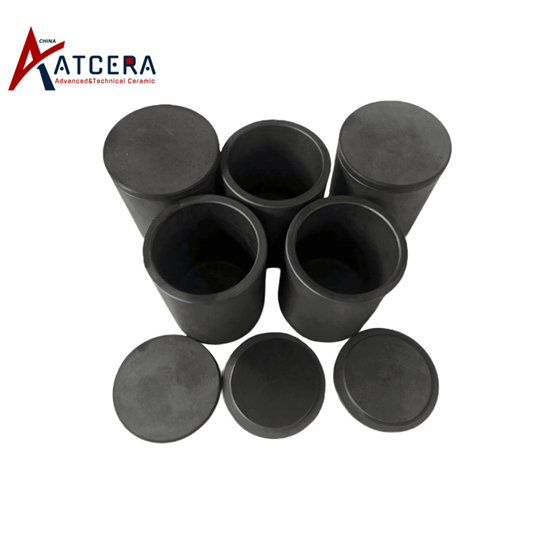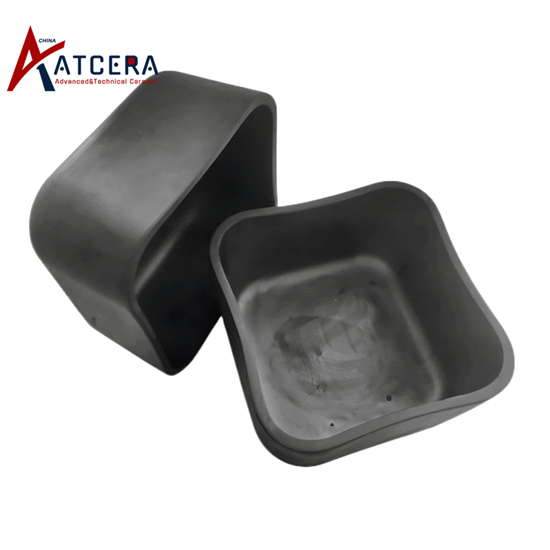¿Está cansado de lidiar con problemas de corrosión y contaminación al fundir materiales en sus procesos industriales? No busque más. En este artículo, exploraremos los numerosos beneficios de utilizar un crisol de SiC (carburo de silicio) resistente a la corrosión para todas sus necesidades de fusión.
Un crisol de SiC es una alternativa duradera a los crisoles tradicionales fabricados con otros materiales como grafito o arcilla. Ofrece una excelente resistencia a altas temperaturas, choques térmicos y productos químicos, lo que lo hace ideal para diversas aplicaciones de fusión. Ya sea que esté fundiendo metales, aleaciones o cerámicas, un crisol de SiC puede resistir las duras condiciones y mantener su integridad, lo que reduce el riesgo de contaminación y mejora la calidad de su producto final.
Además de sus excepcionales propiedades de resistencia, un crisol de SiC también tiene una excelente conductividad térmica, lo que garantiza un calentamiento uniforme y reduce las posibilidades de que se formen puntos calientes. Esto da como resultado una mayor eficiencia y ahorro de costos en sus procesos de fusión.
Únase a nosotros mientras profundizamos en las ventajas de utilizar un crisol de SiC resistente a la corrosión y cómo puede revolucionar sus operaciones de fusión.
Comprender la corrosión en crisoles
La corrosión es un desafío importante al que se enfrentan muchas industrias cuando se trata de fundir y procesar materiales. Los crisoles tradicionales, a menudo fabricados con materiales como grafito o arcilla, son susceptibles a la corrosión, especialmente cuando se exponen a altas temperaturas, productos químicos agresivos o materiales fundidos agresivos.
Esta corrosión puede provocar una serie de problemas, incluida la degradación de la integridad estructural del crisol, la introducción de impurezas en el material fundido y la necesidad de reemplazar frecuentemente el crisol. La corrosión también puede hacer que el crisol se vuelva quebradizo y propenso a agrietarse o romperse, lo que puede interrumpir el proceso de fusión y potencialmente crear riesgos para la seguridad.
Comprender los mecanismos de corrosión en crisoles es crucial para encontrar soluciones efectivas. Factores como la composición química del material fundido, la temperatura de funcionamiento y la exposición a diversas sustancias reactivas pueden contribuir a la velocidad y la gravedad de la corrosión. Al abordar estas causas subyacentes, las industrias pueden mitigar los riesgos y desafíos asociados con la corrosión en sus operaciones de fundición.
Los beneficios de los crisoles de SiC resistentes a la corrosión
Ante las limitaciones de los materiales de crisol tradicionales, las industrias han buscado alternativas más duraderas y resistentes a la corrosión. Una de esas soluciones que ha ganado un amplio reconocimiento es el uso de crisoles de carburo de silicio (SiC). Estos crisoles especializados ofrecen una variedad de beneficios que los convierten en una opción convincente para una amplia variedad de aplicaciones de fusión.
SiC is a ceramic material that is renowned for its exceptional resistance to corrosion, thermal shock, and high temperatures. Unlike graphite or clay crucibles, SiC crucibles can withstand the harsh conditions encountered in many industrial melting processes, including exposure to molten metals, aggressive chemicals, and extreme temperatures. This enhanced resistance to corrosion and degradation ensures that SiC crucibles maintain their structural integrity and performance over an extended period, reducing the need for frequent replacement.
Moreover, the unique properties of SiC crucibles, such as their excellent thermal conductivity and heat resistance, offer significant advantages in terms of melting efficiency and product quality. By providing consistent and uniform heating throughout the crucible, SiC crucibles help to minimize hot spots and ensure that the molten material is heated evenly, leading to improved process control and better overall results.

Enhanced Durability and Longer Lifespan
One of the primary advantages of using a corrosion-resistant SiC crucible is its exceptional durability and extended lifespan. Unlike traditional crucibles that can quickly deteriorate due to the harsh operating conditions, SiC crucibles are engineered to withstand the rigors of high-temperature melting environments.
The inherent resistance of SiC to chemical attack, thermal shock, and physical wear and tear allows these crucibles to maintain their structural integrity for significantly longer periods. This extended lifespan translates into reduced downtime, fewer interruptions in production, and lower maintenance costs associated with frequent crucible replacements.
Moreover, the durability of SiC crucibles enables them to handle a wider range of molten materials, including highly corrosive substances, without compromising their performance. This versatility is particularly valuable in industries that work with a diverse array of materials, as it allows for a single crucible solution to be utilized across multiple melting processes.
Improved Melting Efficiency and Heat Transfer
In addition to their superior corrosion resistance, SiC crucibles also offer enhanced thermal properties that contribute to improved melting efficiency and heat transfer. The high thermal conductivity of SiC allows for efficient and uniform heat distribution throughout the crucible, ensuring that the molten material is heated evenly and consistently.
This improved heat transfer results in several key benefits. First, it helps to minimize hot spots within the crucible, which can lead to uneven heating and potentially compromise the quality of the final product. By maintaining a more consistent temperature profile, SiC crucibles help to ensure that the melting process is optimized, leading to better control over the material properties and characteristics.
Furthermore, the efficient heat transfer capabilities of SiC crucibles can translate into energy savings for the industrial operation. By requiring less energy input to achieve the desired melting temperatures, these crucibles can contribute to overall cost reductions and improved sustainability in the manufacturing process.
Reduced Contamination and Impurities
One of the significant challenges associated with traditional crucible materials is the risk of contamination and the introduction of impurities into the molten material. This is a critical concern for industries that require high-purity products, such as those in the electronics, aerospace, or medical device manufacturing sectors.
SiC crucibles, however, offer a distinct advantage in this regard. The inherent corrosion resistance of SiC ensures that the crucible material itself does not leach or react with the molten material, minimizing the risk of contamination. This is particularly important when working with sensitive or high-value materials, where even trace amounts of impurities can have a detrimental impact on the final product's performance and quality.
By reducing the potential for contamination, SiC crucibles help to maintain the purity and integrity of the melted material, contributing to improved product quality and consistency. This, in turn, can lead to increased customer satisfaction, reduced waste, and higher overall process efficiency.
Cost Savings and Return on Investment
While the initial investment in a SiC crucible may be higher compared to traditional crucible materials, the long-term benefits and cost savings can make it a highly attractive and cost-effective solution.
The extended lifespan of SiC crucibles, as discussed earlier, translates into fewer replacement costs and reduced downtime associated with crucible failures. This, in turn, leads to a lower overall cost of ownership and a better return on investment over the life of the crucible.
Additionally, the improved melting efficiency and reduced energy consumption of SiC crucibles can contribute to significant cost savings in the manufacturing process. By optimizing the heating and melting operations, industries can benefit from lower energy bills and improved overall process sustainability.
Furthermore, the reduced risk of contamination and the improved quality of the final product can have far-reaching financial implications. Minimizing the need for rework, scrap, or product recalls can lead to substantial cost savings and a better bottom line for the business.
Applications and Industries that Benefit from SiC Crucibles
The corrosion-resistant and high-performance properties of SiC crucibles make them a versatile solution for a wide range of industries and applications. Some of the key sectors that can benefit from the use of SiC crucibles include:
1. Metals and Alloy Melting: SiC crucibles are well-suited for melting a variety of metals and alloys, including aluminum, copper, brass, and stainless steel, due to their exceptional resistance to high temperatures and molten metal corrosion.
2. Glass and Ceramic Manufacturing: The thermal shock resistance and chemical inertness of SiC crucibles make them ideal for melting and processing glass, ceramics, and other high-temperature materials.
3. Electronics and Semiconductor Industry: The purity and contamination-resistant nature of SiC crucibles are crucial in the production of electronic components, semiconductors, and other high-tech products that require the utmost material quality.
4. Aerospace and Defense: SiC crucibles are commonly used in the production of specialized alloys and advanced materials for the aerospace and defense industries, where reliability, performance, and safety are paramount.
5. Medical Device Manufacturing: The corrosion resistance and purity of SiC crucibles are essential in the production of medical devices, implants, and other healthcare-related products that require strict quality control and material integrity.
6. Jewelry and Precious Metals: SiC crucibles are well-suited for melting and casting precious metals, such as gold, silver, and platinum, without the risk of contamination or degradation.
Across these diverse industries, the benefits of using a corrosion-resistant SiC crucible – including enhanced durability, improved melting efficiency, reduced contamination, and cost savings – make it a compelling choice for companies seeking to optimize their melting operations and maintain the highest product quality.

Choosing the Right SiC Crucible for Your Melting Needs
When selecting a SiC crucible for your specific melting requirements, it is essential to consider several key factors to ensure that you choose the right solution for your needs.
First and foremost, it is crucial to carefully assess the characteristics of the materials you will be melting, including their chemical composition, melting point, and any potential corrosive properties. This information will help you determine the appropriate grade and composition of the SiC crucible that can withstand the harsh operating conditions and provide the necessary level of corrosion resistance.
Additionally, the size and shape of the crucible should be tailored to the specific requirements of your melting process and the volume of material you need to handle. SiC crucibles are available in a wide range of sizes and geometries, allowing you to select the most suitable option for your production needs.
Otras consideraciones importantes al elegir un crisol de SiC incluyen el proceso de fabricación, las medidas de control de calidad y la reputación y experiencia del proveedor. Optar por un crisol de SiC de alta calidad y bien diseñado de un fabricante acreditado puede garantizar que recibirá un producto duradero, confiable y consistente que brindará el rendimiento y los beneficios deseados.
Conclusión
En conclusión, el uso de un crisol de SiC resistente a la corrosión puede cambiar las reglas del juego para las industrias que dependen de la fusión y el procesamiento de una amplia gama de materiales. La durabilidad excepcional, la eficiencia de fusión mejorada, el menor riesgo de contaminación y el ahorro de costos a largo plazo que ofrecen los crisoles de SiC los convierten en una solución muy atractiva para una variedad de aplicaciones industriales.
Al invertir en un crisol de SiC, las empresas pueden optimizar sus operaciones de fusión, mejorar la calidad del producto y mejorar su competitividad general en el mercado. A medida que continúa creciendo la demanda de soluciones de fusión de alto rendimiento, sostenibles y rentables, la adopción de crisoles de SiC está a punto de generalizarse cada vez más en diversas industrias.
Ya sea que trabaje con metales, aleaciones, cerámicas o materiales especializados, un crisol de SiC resistente a la corrosión puede brindarle el rendimiento confiable y eficiente que necesita para llevar sus procesos de fusión a nuevas alturas. Aproveche los beneficios de esta tecnología innovadora y libere todo el potencial de sus operaciones industriales.


























